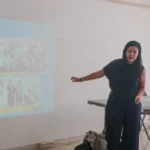Tired of pre-defined problems stifling student creativity? This article explores how letting students define the challenges in project-based learning unlocks deeper engagement and diverse learning pathways. HighlightsWho is Kim Flintoff?Reflecting on Challenge-Based Learning and Its LimitationsEffective Challenge-Based Learning and the Importance of Grappling with ProblemsThe Danger of Superficial Solutions and Current Teaching PracticesOrganizing Learning Activities...
RELATED ARTICLES
© NewInAsia.com 2025








